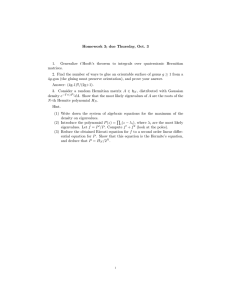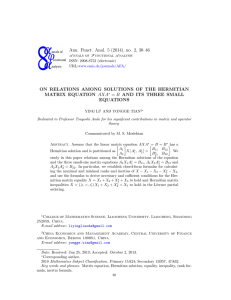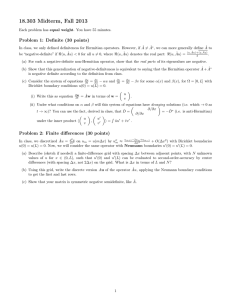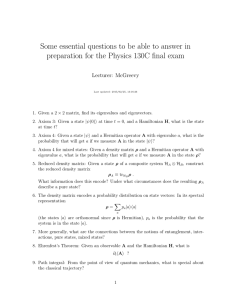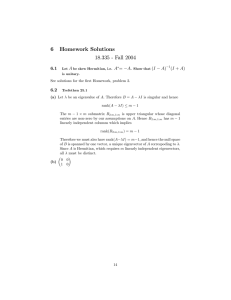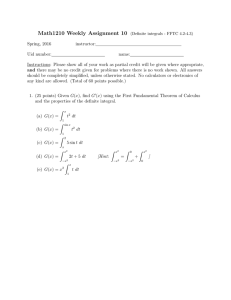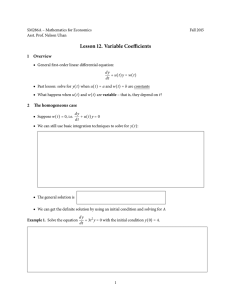, vol.1, no.2, 2011, 109-129 ISSN: 1792-7625 (print), 1792-8850 (online)
advertisement
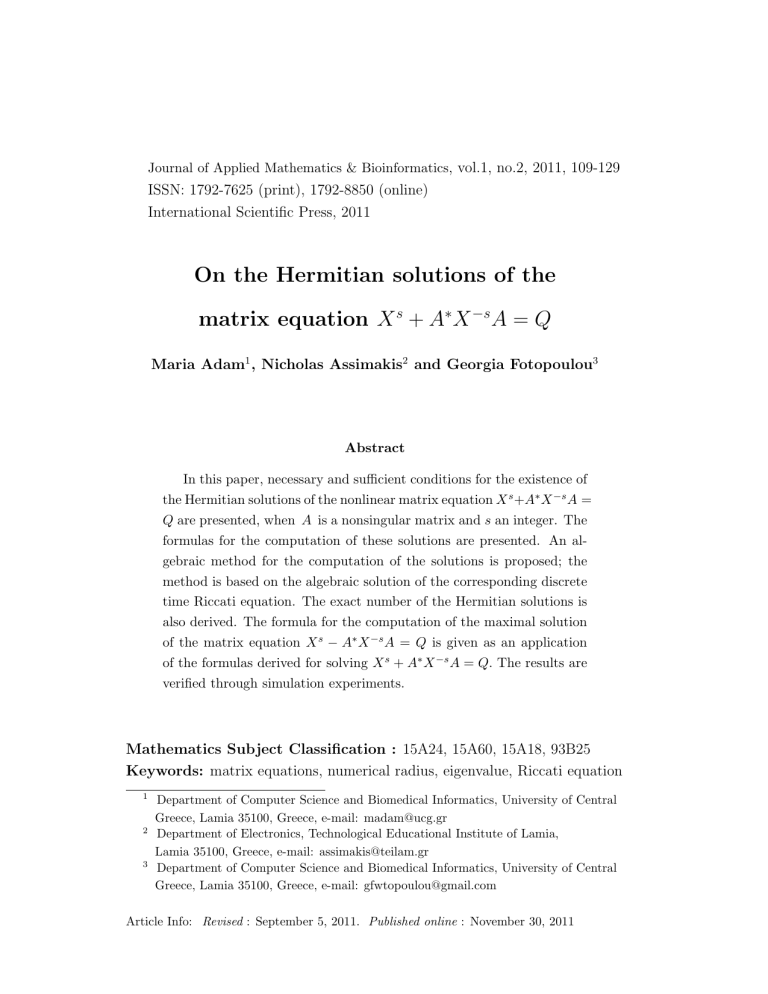
Journal of Applied Mathematics & Bioinformatics, vol.1, no.2, 2011, 109-129
ISSN: 1792-7625 (print), 1792-8850 (online)
International Scientific Press, 2011
On the Hermitian solutions of the
matrix equation X s + A∗X −sA = Q
Maria Adam1 , Nicholas Assimakis2 and Georgia Fotopoulou3
Abstract
In this paper, necessary and sufficient conditions for the existence of
the Hermitian solutions of the nonlinear matrix equation X s +A∗ X −s A =
Q are presented, when A is a nonsingular matrix and s an integer. The
formulas for the computation of these solutions are presented. An algebraic method for the computation of the solutions is proposed; the
method is based on the algebraic solution of the corresponding discrete
time Riccati equation. The exact number of the Hermitian solutions is
also derived. The formula for the computation of the maximal solution
of the matrix equation X s − A∗ X −s A = Q is given as an application
of the formulas derived for solving X s + A∗ X −s A = Q. The results are
verified through simulation experiments.
Mathematics Subject Classification : 15A24, 15A60, 15A18, 93B25
Keywords: matrix equations, numerical radius, eigenvalue, Riccati equation
1
2
3
Department of Computer Science and Biomedical Informatics, University of Central
Greece, Lamia 35100, Greece, e-mail: madam@ucg.gr
Department of Electronics, Technological Educational Institute of Lamia,
Lamia 35100, Greece, e-mail: assimakis@teilam.gr
Department of Computer Science and Biomedical Informatics, University of Central
Greece, Lamia 35100, Greece, e-mail: gfwtopoulou@gmail.com
Article Info: Revised : September 5, 2011. Published online : November 30, 2011
110
1
On the Hermitian solutions of the matrix equation X s + A∗ X −s A = Q
Introduction
The central issue of this paper is the investigation and the computation of
the Hermitian solutions of the matrix equation
X s + A∗ X −s A = Q,
(1)
where the nonsingular matrix A ∈ Mn , Mn denotes the set of all n × n
matrices with complex or real entries, A∗ stands for the conjugate transpose
of A, Q ∈ Mn is a Hermitian positive definite matrix and s is an integer.
The matrix equation of the form (1) arises in many applications in various research areas including control theory, ladder networks, dynamic programming,
stochastic filtering and statistics; see [2, 8, 12] and the references given therein.
In the case that A is nonsingular and s = 1, necessary and sufficient conditions for the existence of a positive definite solution of the matrix equation (1)
have been investigated by many authors [2, 3, 7, 8, 12] and formulas for the
computation of Hermitian and non-Hermitian solutions can be found in [3].
The study only of the positive definite solutions of the nonlinear matrix
equation (1) has been presented in [1] and the more general equation X s +
A∗ X −t A = Q, with A nonsingular, has been considered in [4, 6, 11] (see also
references therein) for s, t positive integers and in [5] when s ≥ 1, 0 < t ≤ 1
and 0 < s ≤ 1, t ≥ 1; there some existence conditions and properties of its
positive definite solutions are obtained.
To describe our results, we introduce some notations and definitions. For
a Hermitian matrix A ∈ Mn , the notation A > 0 (A ≥ 0) means that A
is a positive definite (semidefinite) matrix and for the Hermitian matrices
A, B ∈ Mn , the notation A > B (A ≥ B) means that A − B > 0 (A − B ≥ 0).
For A ∈ Mn , λi (A) denotes an eigenvalue of A, σ(A) the spectrum of A,
ρ(A) = max{|λi (A)| : λi (A) ∈ σ(A)}
p
kAk = max{ λi (A∗ A) : λi (A∗ A) ∈ σ(A∗ A)}
(2)
denotes the spectral radius and spectral norm of A, respectively, and
r(A) = max{|x∗ Ax| : for each vector x ∈ Cn , with x∗ x = 1}
(3)
denotes the numerical radius of A. It is also known [2, 3, 8, 12] that, when
X > 0 is a solution of X +A∗ X −1 A = Q, then there exist minimal and maximal
M. Adam, N. Assimakis and G. Fotopoulou
111
solutions Xmin and Xmax , respectively, such that 0 < Xmin ≤ X ≤ Xmax
for any solution X > 0. The minimal and maximal solutions are referred as
the extreme solutions. Moreover, the existence of a positive definite solution
depends on the numerical radius of the matrix Q−1/2 AQ−1/2 , [8, Theorem 5.2].
Note that, setting in (1)
Y = Xs
(4)
Y + A∗ Y −1 A = Q.
(5)
we obtain
In this paper, we focus on the computation of the Hermitian solutions of
the matrix equation (1), with A ∈ Mn a nonsingular matrix, Q > 0 and s an
integer with s ≥ 1. In Section 2, specific necessary and sufficient conditions
for the existence of positive definite solutions of (1) are presented and formulas
for computing the Hermitian solutions of (1) are given. In Section 3, an algebraic method for computing the Hermitian solutions is proposed; the method
is based on the algebraic solution of the corresponding discrete time Riccati
equation. The number of Hermitian solutions of (1) is also derived (if such
solutions exist). In Section 4, the Hermitian solutions of the matrix equation
X s − A∗ X −s A = Q are discussed and the maximal solution is formulated as
an implementation of the results for solving X s + A∗ X −s A = Q. In Section 5,
simulation results are given to illustrate the efficiency of the proposed results.
2
Existence and formulas of Hermitian solutions of X s + A∗X −sA = Q
In the first part of this section, in order to present necessary and sufficient
conditions for the existence of Hermitian solutions of the nonlinear matrix
equation (1), we utilize the properties of numerical radius and the following
proposition.
Proposition 2.1. [1, Theorem 2] Let A ∈ Mn be a nonsingular matrix
and Q ∈ Mn with Q > 0. The equation (1) has a positive definite solution
X ∈ Mn if and only if for the numerical radius of Q−1/2 AQ−1/2 holds
1
r(Q−1/2 AQ−1/2 ) ≤ .
2
(6)
112
On the Hermitian solutions of the matrix equation X s + A∗ X −s A = Q
It is well known that for a Hermitian matrix A holds kAk = ρ(A) and by
[10, p. 12] and the definitions of radius in (2), (3) we conclude :
r(A) = max{|λmin (A)|, |λmax (A)|} = ρ(A)
Thus, we have the equality:
r(A) = ρ(A) = kAk
(7)
Lemma 2.1. [10, p. 44] Suppose that A ∈ Mn is a matrix with nonnegative
∗
denotes the Hermitian
real entries. Then r(A) = ρ(HA ), where HA = A+A
2
part of A.
Proposition 2.2. Suppose that Q−1/2 AQ−1/2 ∈ Mn has nonnegative real
entries and A ∈ Mn is a nonsingular matrix. The equation (1) has at least
one positive definite solution if and only if
1
kQ−1/2 HA Q−1/2 k ≤ ,
2
(8)
where HA = 12 (A + A∗ ).
Proof. Since HA is Hermitian and Q−1/2 > 0, it follows that Q−1/2 HA Q−1/2
is Hermitian as well, thus from (7) arises:
kQ−1/2 HA Q−1/2 k = ρ(Q−1/2 HA Q−1/2 )
(9)
Moreover, from Lemma 2.1 we derive
r(Q−1/2 AQ−1/2 ) = ρ(HQ−1/2 AQ−1/2 )
1 −1/2
∗
−1/2
=ρ
(Q
(A + A )Q
) = ρ(Q−1/2 HA Q−1/2 ).
2
Combining the last relation, (6) and (9) in Proposition 2.1 we derive (8).
In the second part of this section, the formulas of all Hermitian solutions of
(1) are given by the following theorem, the existence of which is guaranteed
by Proposition 2.1.
M. Adam, N. Assimakis and G. Fotopoulou
113
Theorem 2.3. Let A ∈ Mn be a nonsingular matrix with r(Q−1/2 AQ−1/2 ) ≤
1
and Y ∈ Mn be a positive definite solution of the equation (5). For each Y ,
2
there exist a unitary matrix U ∈ Mn , which diagonalizes Y, and a Hermitian
solution X ∈ Mn of the matrix equation (1), such that
(i) if s = 2` + 1, ` = 0, 1, . . . , then
p
p
p
s
s
s
X = U diag
λ1 (Y ), λ2 (Y ), . . . , λn (Y ) U ∗ ,
(10)
(ii) if s = 2`, ` = 1, 2, . . . , then
p
p
p
X = U diag ± s λ1 (Y ), ± s λ2 (Y ), . . . , ± s λn (Y ) U ∗ ,
(11)
where λi (Y ) ∈ σ(Y ), i = 1, 2, . . . , n, and ± in (11) is denoted all the possible
combinations of the associated algebraic signs.
Proof. Since r(Q−1/2 AQ−1/2 ) ≤ 12 , the matrix equation (1) has at least one
positive definite solution by Proposition 2.1; also, the same condition guarantees the existence of at least one positive definite solution of (5) by [8, Theorem
5.2], this solution is denoted by Y ∈ Mn . According to the spectral theorem
for Y , there exists a unitary matrix U ∈ Mn such that
Y = U DU ∗ ,
(12)
where D = diag(λ1 (Y ), . . . , λn (Y )) and λi (Y ) ∈ σ(Y ) are positive real numbers. Using the unitarity of U ∈ Mn and the formulas of X, Y from (10), (12),
we derive :
X s + A∗ X −s A
s
p
p
= U diag( s λ1 (Y ), . . . , s λn (Y ) )U ∗
−s
p
p
A
+ A∗ U diag( s λ1 (Y ), . . . , s λn (Y ) )U ∗
p
p
s
= U diag( s λ1 (Y ), . . . , s λn (Y ) ) U ∗
−s
p
p
s
s
∗
∗ −1
+ A (U )
diag( λ1 (Y ), . . . , λn (Y ) )
U −1 A
= U DU ∗ + A∗ (U ∗ )−1 D−1 U −1 A
= Y + A∗ Y −1 A = Q
Hence, X in (10) consists a solution of (1) and due to λi (Y ) > 0 it is a positive
definite solution. Similarly, it can be shown that X in (11) is a Hermitian
solution of (1).
On the Hermitian solutions of the matrix equation X s + A∗ X −s A = Q
114
Remark 2.1. Concluding the section we note that :
(i) Proposition 2.1 guarantees that the existence of Hermitian solutions of
(1) depends on the numerical range of Q−1/2 AQ−1/2 and Theorem 2.3
determines the definiteness of these solutions, which depends on s; when
s is an odd number, only positive definite solutions are derived and formulated by (10); when s is an even number, then among the (Hermitian)
solutions there exist negative definite and indefinite solutions, which are
formed by (11). The simple-closed forms, which are proposed in Theorem
2.3 for computing all the Hermitian solutions of (1), generalize the results
in [1, Theorem 2], that are referred only to positive definite solutions.
(ii) The Hermitian solutions in (11) are linear dependent, since these are in
pairs opposite.
(iii) The condition for the existence of solutions of (1), which is related to
the numerical range of Q−1/2 AQ−1/2 in Proposition 2.1, is more general
than the formed conditions in [6, Theorem 3.1]
1
λmax (A∗ A) < (λmin (Q))2
4
(13)
and in [4, Theorem 2.3]
1
λmin (A∗ A) < (λmin (Q))2
4
(14)
and
α1s−1
λmax (A A) ≤
2
∗
r
s
1
(λmin (Q))s+1 ,
2
(15)
2s
s
∗
where α1 is the solution of the
qequation x −λmax (Q)x +λmin (A A) = 0,
that lies in the interval 0, s 12 λmin (Q) ; when (13) holds or the conditions (14) and (15) are satisfied, then some positive definite solutions are
described in [4, 6] through matrix sets but not through formulas. Notice
that in Example 2 and for s = 3, the associated matrix equation has
Hermitian solutions, although only the inequality in (14) is verified.
M. Adam, N. Assimakis and G. Fotopoulou
3
115
Computation of Hermitian solutions of
X s + A∗X −sA = Q
Let r(Q−1/2 AQ−1/2 ) ≤ 21 and Y be a positive definite solution of (5). Working as in [2]-[3], we are able to derive a Riccati equation, which is equivalent
to the matrix equation (5). In particular, (5) can be written as
Y = Q − A∗ Y −1 A,
whereby the following equivalent equation arises :
−1
−1 ∗ −1
Y = Q − A∗ Q − A∗ Y −1 A
A = Q − A∗ A−1 (A∗ )−1 QA−1 − Y −1
(A ) A
−1
∗
= Q + A∗ A−1 Y −1 + (− (A∗ )−1 QA−1 )
A∗ A−1
Substituting in the above equation
F = A∗ A−1 and G = − (A∗ )−1 QA−1
the related discrete time Riccati equation is derived :
−1 ∗
Y = Q + F Y −1 + G
F
(16)
(17)
Therefore (5) is equivalent to the related discrete time Riccati equation (17),
for the solution of which one may use the algebraic Riccati Equation Solution
Method, [2, 3].
Specifically, from the Riccati equation’s parameters in (16), the following
matrix is formed
"
#
−1 ∗
−1
−1
A
A
−A
QA
Φ+ =
,
(18)
QA−1 A∗ A∗ A−1 − QA−1 QA−1
"
#
O
−I
which satisfies (Φ+ )∗ JΦ+ = J, where J =
, i.e., Φ+ is a symplecI
O
tic matrix. All the eigenvalues of Φ+ are non-zero (0 ∈
/ σ(Φ+ )) and it may be
diagonalized in the form
Φ+ = W LW −1 ,
where L is a 2n × 2n diagonal matrix with diagonal entries the eigenvalues of
Φ+
"
#
L1 O
L=
(19)
O L2
116
On the Hermitian solutions of the matrix equation X s + A∗ X −s A = Q
and W contains the corresponding eigenvectors
"
#
W11 W12
W =
.
W21 W22
(20)
In the case that (5) is solvable, then all its solutions Yj , j = 1, 2, . . . , 2n are
given by the formulas:
Yj = W21 (W11 )−1 and
Yj = W22 (W12 )−1 ,
(21)
where the block matrices W11 , W12 , W21 , W22 are defined by the partition of
W in (20) following every different permutation of its column [3, Propositions
1,2]. Among Yj there exist positive definite solutions for some j = 1, 2, . . . , 2n,
therefore Theorem 2.3 can be applied, i.e., there exist unitary matrices Uj , and
D = diag(λ1 (Yj ), . . . , λn (Yj )) > 0, with λi (Yj ) ∈ σ(Yj ) such that the solutions
of (1) depend on s; in particular the positive definite solutions are given by
(10) and the Hermitian solutions are formulated by (11).
We remind that Φ+ is a symplectic matrix and its eigenvalues occur in
reciprocal pairs. Therefore, we may arrange them in the diagonal matrix L
in (19) so that L1 contains all the eigenvalues of Φ+ lying outside the unit
circle, and L2 = (L1 )−1 . The above process defines a corresponding (special)
arrangement of eigenvectors of Φ+ in W, which we denote by
"
#
Ŵ11 Ŵ12
.
Ŵ =
Ŵ21 Ŵ22
Using the matrix Ŵ , the unique positive definite solutions of the discrete time
Riccati equation in (17) coincide with the extreme solutions of (5) and these
are formed :
Ymax = Ŵ21 (Ŵ11 )−1 > 0
and
Ymin = Ŵ22 (Ŵ12 )−1 > 0
(22)
Moreover, it is well known [2, 3] that, when A ∈ Mn is nonsingular,
the existence of a finite number of positive definite solutions of the matrix
equation (5) depends on the eigenvalues of the matrix Φ+ . In the following,
V (λi (Φ+ )) denotes the eigenspace corresponding to eigenvalue λi (Φ+ ) and
dim(V (λi (Φ+ ))) denotes its dimension.
M. Adam, N. Assimakis and G. Fotopoulou
117
Theorem 3.1. Let A ∈ Mn be a nonsingular matrix, Φ+ be the matrix
in (18) and assume that the matrix equation X s + A∗ X −s A = Q has at least
one positive definite solution. If dim(V (λi (Φ+ ))) = 1 for every eigenvalue
λi (Φ+ ), i = 1, 2, . . . , 2n, with |λi (Φ+ )| 6= 1, then there exists a finite number
of Hermitian solutions (h.s.) of (1). In particular, when s is an even number,
then the number of solutions is equal to
# h.s. = 2n
m
Y
(nj + 1)
(23)
j=1
and when s is an odd number, then the number of positive definite solutions
(h.p.d.s.) is given by
# h.p.d.s. =
m
Y
(nj + 1).
(24)
j=1
If A, Q are real matrices, then among the h.s. and h.p.d.s. there exist real
symmetric solutions (r.s.s.) (or real positive symmetric solutions (r.p.s.s.)) of
(1) with
# r.s.s. = 2n
p+q
Y
(nk + 1); for s = 2`, ` = 1, 2, . . .
(25)
k=1
p+q
# r.p.s.s. =
Y
(nk + 1); for s = 2` + 1, ` = 0, 1, . . .
(26)
k=1
where m is the number of the distinct eigenvalues of Φ+ , that lie outside the
unit circle, with algebraic multiplicity nj , j = 1, 2, . . . , m, p is the number of
real distinct eigenvalues of Φ+ lying outside the unit circle, q is the number
of complex conjugate pairs of eigenvalues lying outside the unit circle, with
algebraic multiplicity nk , k = 1, 2, . . . , p + q.
Proof. Assume that X ∈ Mn is a positive definite solution of (1). According to Theorem 2.3, every positive definite solution X ∈ Mn of (1) is related
to a positive definite solution Y ∈ Mn of (5) by (4). Hence, the unique symplectic matrix Φ+ in (18) corresponds to the two matrix equations (5) and (1).
Thus, when s = 2` + 1, for ` = 0, 1, . . . , the total number of positive definite
(real positive symmetric) solutions of (1) is the same as in [1, 3] and is given
by (24), (26), respectively, while when s = 2`, ` = 1, 2, . . . , the total number of
118
On the Hermitian solutions of the matrix equation X s + A∗ X −s A = Q
Hermitian (real symmetric) solutions is given by (23), (25), respectively, since
the h.s. and r.s.s. depend on all the permutations of the sign of sth root of
eigenvalues of Y , (see formula of X in (11)).
Remark 3.1.
(i) It is clear that for s = 1, the number of solutions in (24) and (26) is the
same as in [3, Theorem 9].
(ii) We remind that the Hermitian solutions are linear dependent according
to statement (ii) in Remark 2.1; consequently, when s is an even number,
the number of linear independent Hermitian solutions of (1) is equal to
n−1
# h.s. = 2
m
Y
(nj + 1),
(27)
j=1
and the number of linear independent real symmetric solutions of (1) is
equal to
n−1
# r.s.s. = 2
p+q
Y
(nk + 1).
(28)
k=1
4
Maximal solution of X s − A∗X −sA = Q
It is well known [3] that, when A ∈ Mn is nonsingular and Q > 0, there
always exist the extreme solutions of equation X − A∗ X −1 A = Q, a unique
positive definite solution, which is the maximal, and a unique negative definite
solution, which is the minimal; in this section the Hermitian solutions of the
matrix equation
X s − A∗ X −s A = Q
(29)
are discussed. It will be proved that these solutions are related to the maximal
solution of an equation of the type of (5). The matrix equation (29) using the
119
M. Adam, N. Assimakis and G. Fotopoulou
Matrix Inversion Lemma4 can be written:
X s = Q + A∗ X −s A = Q + A∗ (X s )−1 A = Q + A∗ Q + A∗ X −s A
i
h
−1
AQ−1 A
= Q + A∗ Q−1 − Q−1 A∗ X s + AQ−1 A∗
−1
= Q + A∗ Q−1 A − A∗ Q−1 A∗ X s + AQ−1 A∗
AQ−1 A
−1
A
Setting in the above equality
B = AQ−1 A
(30)
C = Q + A∗ Q−1 A + AQ−1 A∗
(31)
Y
= X s + AQ−1 A∗
(32)
we have :
Y + B ∗ Y −1 B = C
(33)
Remind that the equation in (33) is of the type of (5); C in (31) is a positive definite matrix as sum of positive definite matrices (noticing that A∗ Q−1 A, AQ−1 A∗
are positive definite matrices), and B in (30) is a nonsingular matrix due to
detB = (detA)2 (detQ)−1 6= 0.
Thus, it becomes obvious that the solutions of (29) can be derived through
the solutions of (33), whose existence is related to the numerical radius of
C −1/2 BC −1/2 [2, 3, 8].
Moreover, rewritting (32) as
X s = Y − AQ−1 A∗ ,
(34)
it is evident that the solving of (29) is related to the existence of sth root of
the matrix Y − AQ−1 A∗ in (34), the existence of which is guaranteed by the
following lemma.
Lemma 4.1. [9, Theorem 7.2.6] Let A ∈ Mn be a positive semidefinite
matrix and let ν ≥ 1 be a given integer. Then there exists a unique positive
semidefinite matrix B such that B ν = A.
In the following theorem conditions and formulas for the solutions of (29)
are presented.
4
We remind that for the matrices K, L, M, N ∈ Mn with K, M nonsingular the Matrix
Inversion Lemma is given: (K + LM N )−1 = K −1 − K −1 L(M −1 + N K −1 L)−1 N K −1
120
On the Hermitian solutions of the matrix equation X s + A∗ X −s A = Q
Theorem 4.1. Let B ∈ Mn be the nonsingular matrix in (30), C ∈ Mn
be the positive matrix in (31), with r(C −1/2 BC −1/2 ) ≤ 21 . Then,
(i) there exists a positive definite solution Y ∈ Mn of (33).
(ii) If Ymax ∈ Mn is a maximal solution of (33) with
λmin (Ymax ) > λmax (AQ−1 A∗ ),
then the associated Ψ ≡ Ymax − AQ−1 A∗ by (34) is a positive definite
matrix and the unique maximal solution Xmax ∈ Mn of the matrix
equation (29) is formed
p
p
p
Xmax = U diag s λ1 (Ψ), s λ2 (Ψ), . . . , s λn (Ψ) U ∗ ,
(35)
where λi (Ψ) ∈ σ(Ψ), i = 1, 2, . . . , n, and U ∈ Mn is a unitary matrix, which
diagonalizes Ψ.
Additionally, if s = 2`, ` = 1, 2, . . . , then there exist 2n Hermitian solutions
X ∈ Mn of (29) including the maximal one, which are derived by (35) using
p
2n combinations of the signed s λi (Ψ), with λi (Ψ) ∈ σ(Ψ).
Proof. (i) By the assumption of the numerical radius of C −1/2 BC −1/2 and
Proposition 2.1 for s = 1, it is obvious that the matrix equation (33) has at
least one positive definite solution.
(ii) Since Ymax is a Hermitian matrix, it is clear that Ψ is one. Also,
Ymax , AQ−1 A∗ are positive definite matrices, thus its eigenvalues are indexed
in increasing order as
0 < λmin (Ymax ) ≤ · · · ≤ λmax (Ymax ),
0 < λmin (AQ−1 A∗ ) ≤ · · · ≤ λmax (AQ−1 A∗ ),
respectively. According to Weyl’s Theorem [9, Theorem 4.3.1] for the form of
Ψ ≡ Ymax − AQ−1 A∗ the following inequality holds:
λmin (Ymax ) − λmax (AQ−1 A∗ ) ≤ λmin (Ymax − AQ−1 A∗ ) ≤ λmin (Ymax ) − λmin (AQ−1 A∗ )
Combining the assumption λmin (Ymax ) > λmax (AQ−1 A∗ ) with the left part of
the above inequality we have
λmin (Ψ) = λmin (Ymax − AQ−1 A∗ ) ≥ λmin (Ymax ) − λmax (AQ−1 A∗ ) > 0
M. Adam, N. Assimakis and G. Fotopoulou
121
from which arises Ψ > 0. Since the assumption of Lemma 4.1 is satisfied
by Ψ, there exists a unique positive definite solution of X s = Ψ, which is
denoted Xmax ∈ Mn . Using the unitary matrix U ∈ Mn , which arises from
the diagonalization of Ψ, and the formula of Xmax in (35) the matrix equation
s
Xmax
= Ψ directly is verified; more specifically Xmax is a maximal solution of
(29) due to the uniqueness of maximal Ymax of (33).
It is evident that, when s = 2`, ` = 1, 2, . . . , using all the possible comp
binations of the signed s λi (Ψ) in the diagonal matrix of the formula of the
solutions in (35), all the Hermitian solutions of (29) derived, the total number
of which is equal to 2n .
Remark 4.1.
(i)
Notice that the solution of (29) does not depend only on the solution of (33),
but it is based on the definiteness of the matrix Y − AQ−1 A∗ in (34) as well;
thus searching Hermitian or positive definite solutions of (29) it is required
Ψ > 0, where Ψ is given as in Theorem 4.1.
(ii)
For the computation of Ymax in (ii) of Theorem 4.1 the associated formula in
(22) can be used.
5
Simulation results
Simulation results are given to illustrate the efficiency of the proposed
method. The proposed method computes the Hermitian solutions as verified
through the following simulation examples, using Matlab 6.5.
Example 5.1.
Let the matrices
"
#
"
#
−0.2 0.4
1.2 −0.4
A=
, Q=
0.3 0.7
−0.4 2.3
in the equation X s + A∗ X −s A = Q, s = 2, 3. Obviously, A is a nonsingular matrix, with spectrum σ(A) = {λ1 (A) = −0.3179, λ2 (A) = 0.8179},
and Q > 0, with σ(Q) = {1.0699, 2.4301}. Since r(Q−1/2 AQ−1/2 ) = 0.4691,
Proposition 2.1 guarantees the existence of positive definite solutions of (1)
On the Hermitian solutions of the matrix equation X s + A∗ X −s A = Q
122
and Theorem 2.3 determines the definiteness of these solutions from (10)-(11).
The spectrum of matrix Φ+ in (18) is
σ(Φ+ ) = {λ1 (Φ+ ) = −19.7683, λ2 (Φ+ ) = −2.0634, λ3 (Φ+ ) = −0.0506,
λ4 (Φ+ ) = −0.4846},
with
λ1 (Φ+ ) = 19.7683, λ2 (Φ+ ) = 2.0634, λ3 (Φ+ ) = 0.0506, λ4 (Φ+ ) = 0.4846,
thus Φ+ has m = p = 2 real eigenvalues outside the unit circle, the algebraic
multiplicity of which is n1 = n2 = 1, and q = 0 (all eigenvalues are real
numbers). According to Theorem 3.1 the Riccati Equation Solution Method
can be applied, because its assumptions are verified; the associated number of
Hermitian solutions coincides to the real symmetric one and for s = 2, s = 3
the solutions are computed by (23), (24), respectively, which is equal to
m
m
Y
Y
# h.s. ≡ r.s.s. = 2
(nj +1) = 16, and # h.p.d.s. ≡ r.p.s.s. =
(nj +1) = 4.
2
j=1
j=1
The corresponding eigenvectors of Φ+ are the columns of the matrix
W =
0.5686
−0.1045
0.6915
−0.4331
−0.3944 0.9655
−0.5421 −0.2506
−0.1982 0.0660
−0.7150 −0.0257
−0.4954
−0.7263
−0.1333
−0.4574
.
The positive definite solutions Yj of (5) are computed by (21);
• when s = 2, according to Theorem 2.3 for each Yj the corresponding Hermitian
solutions of (1) are derived by (11) as follows:
"
#
0.0985 0.1163
Y1 =
,
0.1163 0.5504
"
#
"
#
0.2927 0.1134
−0.2084 0.2347
X1 =
,
X2 =
,
0.1134 0.7332
0.2347 0.7038
"
#
"
#
−0.2927 −0.1134
0.2084 −0.2347
X3 =
, X4 =
,
−0.1134 −0.7332
−0.2347 −0.7038
123
M. Adam, N. Assimakis and G. Fotopoulou
"
Y2 =
0.1373 0.2657
0.2657 1.1258
#
0.3147 0.1957
0.1957 1.0428
#
"
X5 =
"
Y3 =
"
,
X6 =
−0.3147 −0.1957
−0.1957 −1.0428
#
1.1106 −0.5740
−0.5740 1.0213
#
1.0133 −0.2897
−0.2897 0.9682
#
X7 =
"
,
"
X9 =
"
,
X8 =
−0.1845 0.3213
0.3213 1.0112
#
0.1845 −0.3213
−0.3213 −1.0112
,
#
,
,
"
,
#
−1.0133 0.2897
X11 =
,
0.2897 −0.9682
"
#
1.1319 −0.4580
Y4 =
,
−0.4580 1.6523
"
#
1.0454 −0.1978
X13 =
,
−0.1978 1.2701
"
#
−1.0454 0.1978
X15 =
,
0.1978 −1.2701
X10 =
"
"
X12 =
−0.3674 0.9877
0.9877 −0.2137
#
0.3674 −0.9877
−0.9877 0.2137
#
,
,
"
#
−0.3443 −1.0067
X14 =
,
−1.0067 0.7993
"
#
0.3443 1.0067
X16 =
.
1.0067 −0.7993
Also, we observe that the Hermitian solutions are in pairs opposite, thus it is
verified the statement (ii) in Remark 2.1 and the number of linear independent
solutions is given by (27)
# h.s. ≡ r.s.s. = 2
m
Y
(nj + 1) = 8,
j=1
and the associated solutions are X1 , X2 , X5 , X6 , X9 , X10 , X13 , X14 .
• when s = 3, according to Theorem 2.3 for each Yj the corresponding positive
definite solutions of (1) are derived by (10) as follows:
"
#
"
#
0.0985 0.1163
0.4361 0.0962
Y1 =
, X1 = Xmin =
,
0.1163 0.5504
0.0962 0.8100
"
#
"
#
0.1373 0.2657
0.4516 0.1533
Y2 =
, X2 =
,
0.2657 1.1258
0.1533 1.0219
124
On the Hermitian solutions of the matrix equation X s + A∗ X −s A = Q
"
#
0.9993 −0.1950
Y3 =
, X3 =
,
−0.1950 0.9689
"
#
"
#
1.1319 −0.4580
1.0262 −0.1260
Y4 =
, X4 = Xmax =
,
−0.4580 1.6523
−0.1260 1.1693
1.1106 −0.5740
−0.5740 1.0213
#
"
It is also verified that: 0 < Xmin < Xmax .
Example 5.2. Consider s = 3 in equation X s + A∗ X −s A = Q with
1.20 −0.30 0.10
0.32 0.13 0.12
A = 0.20 0.34 0.12 , Q = −0.30 2.10 0.20 .
0.10
0.20 0.65
0.11 0.17 0.10
In this example, A is a nonsingular matrix with
σ(A) = {λ1 (A) = 0.5660, λ2 (A) = 0.1602, λ3 (A) = 0.0337},
Q is a positive definite matrix with
σ(Q) = {λmin (Q) = 0.5882, λ2 (Q) = 1.1538, λmax (Q) = 2.2080},
and the spectrum of A∗ A is
σ(A∗ A) = {λmin (A∗ A) = 0.0010, λ2 (A∗ A) = 0.0297, λmax (A∗ A) = 0.3241}.
From the previous values of the spectrum it is obvious that
λmax (A∗ A) >
1
(λmin (Q))2 ,
4
i.e., the inequality in (13) is not satisfied, hence Theorem 3.1 in [6] can not be
applied.
6
3
Also, the inequality in (14) is verified; the real root of equation
qx −λmax (Q)x
+
λmin (A∗ A) = 0 is α1 = 0.0761, for which holds α1 ∈ 0,
yields
r
2
α
3 1
λmax (A∗ A) > 1
(λmin (Q))4 .
2
2
3
1
2
λmin (Q)
and
Thus the inequality in (15) is not verified, which means that neither Theorem
2.3 in [4] can be applied.
125
M. Adam, N. Assimakis and G. Fotopoulou
Moreover, the entries of Q−1/2 AQ−1/2 are nonnegative real numbers
0.2886 0.1118 0.1087
Q−1/2 AQ−1/2 = 0.1606 0.1724 0.0758 ,
0.0965 0.1226 0.1124
with kQ−1/2 HA Q−1/2 k = 0.4392, i.e., the inequality (8) is satisfied, thus,
Proposition 2.2 guarantees the existence of positive definite solutions. Since
the spectrum of Φ+ is σ(Φ+ ) = {λ1,2 (Φ+ ) = −204.227 ± 57.086i, λ3 (Φ+ ) =
2.835, λ4 (Φ+ ) = −0.352, λ5,6 (Φ+ ) = −0.0045 ± 0.0013i}, with |λ1,2 (Φ+ )| =
212.0557, |λ3 (Φ+ )| = 2.8351, |λ4 (Φ+ )| = 0.3527, |λ5,6 (Φ+ )| = 0.0047, Φ+
has p = 1 real eigenvalue and q = 1 pair of complex eigenvalues ( m = 3
in total) outside in unit circle, the algebraic multiplicity of which is equal to
1. According to Theorem 3.1 the Riccati Equation Solution Method can be
applied, because its hypotheses are verified and the number of Hermitian solutions is computed by (24) and the number of real symmetric solutions is
computed by (26):
# h.p.d.s. =
p+q
m
Y
Y
(nj + 1) = 8, # r.p.s.s. =
(nk + 1) = 4
j=1
k=1
The positive definite solutions are computed by (10) and given in the following:
0.4388 0.1899 0.1149
X1 = Xmin = 0.1899 0.4160 0.1630 , (minimal solution)
0.1149 0.1630 0.2083
0.5602 0.3133 0.1862
X2 = 0.3133 0.5414 0.2355 ,
0.1862 0.2355 0.2502
0.6373
0.1286 − 0.0644i −0.1748 + 0.0867i
X3 = 0.1286 + 0.0644i
0.4645
0.2128 − 0.1185i ,
−0.1748 − 0.0867i 0.2128 + 0.1185i
0.6880
0.6373
0.1286 + 0.0644i −0.1748 − 0.0867i
X4 = 0.1286 − 0.0644i
0.4645
0.2128 + 0.1185i ,
−0.1748 + 0.0867i 0.2128 − 0.1185i
0.6880
0.7760
0.2570 − 0.0653i −0.1102 + 0.0929i
X5 = 0.2570 + 0.0653i
0.5835
0.2727 − 0.1124i ,
−0.1102 − 0.0929i 0.2727 + 0.1124i
0.7186
126
On the Hermitian solutions of the matrix equation X s + A∗ X −s A = Q
0.7760
0.2570 + 0.0653i −0.1102 − 0.0929i
X6 = 0.2570 − 0.0653i
0.5835
0.2727 + 0.1124i ,
−0.1102 + 0.0929i 0.2727 − 0.1124i
0.7186
0.8241 −0.2260 −0.0688
X7 = −0.2260
1.1677 −0.0135 ,
−0.0688 −0.0135
0.8053
0.9947 −0.1149 0.0131
X8 = Xmax = −0.1149
1.2415 0.0398 , (maximal solution)
0.0131
0.0398 0.8447
The real symmetric solutions are X1 , X2 , X7 , X8 and for every positive definite
solution X, it is verified that 0 < Xmin ≤ X ≤ Xmax .
Example 5.3. Let the matrices A, Q in Example 5.1 and the matrix
equation X s − A∗ X −s A = Q, for s = 2, 3. By (30), (31) the matrices B, C are
computed and since the entries of the matrix
"
#
0.0580
0.0457
C −1/2 BC −1/2 =
0.0331 0.1354
are nonnegative real numbers, according to Proposition 2.2
r(C −1/2 BC −1/2 ) = kC −1/2 HB C −1/2 k = 0.1521,
where HB is the Hermitian part of B. Thus, according to (i) of Theorem 4.1
the existence of positive definite solutions of (33) is quaranteed, which are
computed by (21). Also, the spectrum of matrix Φ+ in (18) is
σ(Φ+ ) = {λ1 (Φ+ ) = −570.3769, λ2 (Φ+ ) = −41.4867, λ3 (Φ+ ) = −0.0241,
λ4 (Φ+ ) = −0.0018},
with
λ1 (Φ+ ) = 570.3769, λ2 (Φ+ ) = 41.4867, λ3 (Φ+ ) = 0.0241, λ4 (Φ+ ) = 0.0018,
thus Φ+ has m = p = 2 real eigenvalues outside the unit circle, the algebraic
multiplicity of which is n1 = n2 = 1, and q = 0 (all eigenvalues are real
numbers). Since the assumptions of Theorem 3.1 are verified, the Riccati
127
M. Adam, N. Assimakis and G. Fotopoulou
Equation Solution Method can be applied for the computation of all positive
definite solutions Yj of equation Y + B ∗ Y −1 B = C; by (24) the associated
number of Yj is equal to
m
Y
# h.p.d.s. ≡ r.p.s.s. =
(nj + 1) = 4
j=1
and by (21) the positive definite solutions Yj are given in the following:
"
#
"
#
0.0056 0.0127
0.1677 0.6179
Y1 =
,
Y2 =
,
0.0127 0.0589
0.6179 2.3193
"
#
"
#
1.2599 −0.7603
1.3386 −0.3144
Y3 =
,
Y4 =
−0.7603
0.5353
−0.3144
3.0618
Also, Y4 = Ymax is the only positive definite solution from the above, which
yields
"
#
1.2540
−0.3875
Ψ4 ≡ Ymax − AQ−1 A∗ =
>0
−0.3875
2.6914
due to σ(Ψ4 ) = {1.1561, 2.7892}.
• For s = 2, according to (ii) of Theorem 4.1 the maximal solution of
X 2 − A∗ X −2 A = Q is computed by (35) and is equal to
"
#
1.1109 −0.1412
Xmax =
.
−0.1412
1.6345
There exist others three different Hermitian solutions, which are given in the
following:
"
#
"
#
−0.9108 −0.6515
−1.1109
0.1412
X1 =
, X2 =
,
−0.6515
1.5057
0.1412 −1.6345
"
#
0.9108
0.6515
X3 =
0.6515 −1.5057
• For s = 3, the positive definite solution of X 3 − A∗ X −3 A = Q is given in the
following, which is computed by (35):
"
#
1.0710 −0.0850
X=
−0.0850
1.3862
128
On the Hermitian solutions of the matrix equation X s + A∗ X −s A = Q
References
[1] M. Adam, On the positive definite solutions of the matrix equation X s +
A∗ X −s A = Q, The Open Applied Mathematics Journal, 5, (2011), 19-25.
[2] M. Adam, N. Assimakis and F. Sanida, Algebraic Solutions of the Matrix
Equations X + AT X −1 A = Q and X − AT X −1 A = Q, International
Journal of Algebra, 2(11), (2008), 501-518.
[3] M. Adam, N. Assimakis, G. Tziallas and F. Sanida, Riccati Equation
Solution Method for the Computation of the Solutions of X +AT X −1 A =
Q and X − AT X −1 A = Q, The Open Applied Informatics Journal, 3,
(2009), 22-33.
[4] J. Cai and G. Chen, Some investigation on Hermitian positive definite
solutions of the matrix equation X s +A∗ X −t A = Q Linear Algebra Appl.,
430, (2009), 2448-2456.
[5] J. Cai and G. Chen, On the Hermitian positive definite solutions of nonlinear matrix equation X s + A∗ X −t A = Q, Applied Mathematics and
Computation, 217, (2010), 117-123.
[6] X. Duan and A. Liao, On the existence of Hermitian positive definite
solutions of the matrix equation X s + A∗ X −t A = Q, Linear Algebra
Appl., 429, (2008), 673-687.
[7] J.C. Engwerda, On the existence of a positive definite solution of the
matrix equation X + AT X −1 A = I, Linear Algebra Appl., 194, (1993),
91-108.
[8] J.C. Engwerda, A.C.M. Ran and A.L. Rijkeboer, Necessary and sufficient
conditions for the existence of a positive definite solution of the matrix
equation X + A∗ X −1 A = Q, Linear Algebra Appl., 186, (1993), 255-275.
[9] R.A. Horn and C.R. Johnson, Matrix Analysis, Cambridge University
Press, Cambridge, 1985.
[10] R.A. Horn and C.R. Johnson, Topics in Matrix Analysis, Cambridge University Press, Cambridge, 1991.
M. Adam, N. Assimakis and G. Fotopoulou
129
[11] X.G. Liu and H. Gao, On the positive definite solutions of the matrix
equations X s ± AT X −t A = In , Linear Algebra Appl., 368, (2003), 83-97.
[12] B. Meini, Efficient computation of the extreme solutions of X +
A∗ X −1 A = Q and X − A∗ X −1 A = Q, Mathematics of Computation,
71(239), (2001), 1189-1204.
